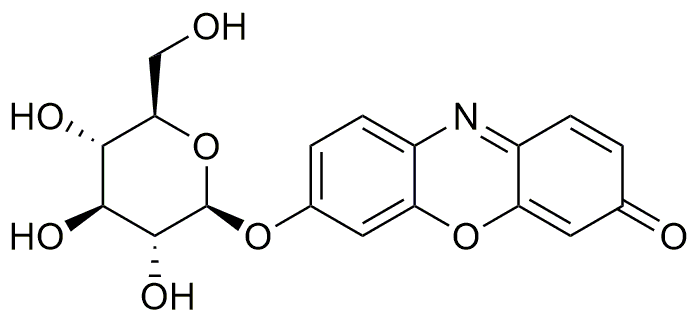Resorufin b-D-glucopyranoside is widely utilized in research focused on:
- Biochemical Assays: This compound serves as a fluorescent substrate in various enzymatic assays, particularly for measuring the activity of β-glucosidases. Its fluorescence allows for sensitive detection, making it valuable in both academic and industrial laboratories.
- Cell Viability Studies: It is used in cell culture experiments to assess cell health and proliferation. The conversion of resorufin from its non-fluorescent precursor provides a straightforward method for evaluating cytotoxicity and cell viability.
- Drug Discovery: In pharmaceutical research, it aids in screening for potential drug candidates by evaluating their effects on specific enzymes. This application is crucial for identifying compounds that can modulate biological pathways effectively.
- Environmental Monitoring: The compound can be employed in assays to detect glucosidase activity in environmental samples, helping researchers monitor soil health and microbial activity, which is essential for ecological studies.
- Diagnostic Applications: Resorufin b-D-glucopyranoside has potential uses in clinical diagnostics, particularly in tests that require the detection of specific enzyme activities related to various diseases, enhancing the accuracy of diagnostic procedures.
Informations générales
Propriétés
Sécurité et réglementation
Applications
Resorufin b-D-glucopyranoside is widely utilized in research focused on:
- Biochemical Assays: This compound serves as a fluorescent substrate in various enzymatic assays, particularly for measuring the activity of β-glucosidases. Its fluorescence allows for sensitive detection, making it valuable in both academic and industrial laboratories.
- Cell Viability Studies: It is used in cell culture experiments to assess cell health and proliferation. The conversion of resorufin from its non-fluorescent precursor provides a straightforward method for evaluating cytotoxicity and cell viability.
- Drug Discovery: In pharmaceutical research, it aids in screening for potential drug candidates by evaluating their effects on specific enzymes. This application is crucial for identifying compounds that can modulate biological pathways effectively.
- Environmental Monitoring: The compound can be employed in assays to detect glucosidase activity in environmental samples, helping researchers monitor soil health and microbial activity, which is essential for ecological studies.
- Diagnostic Applications: Resorufin b-D-glucopyranoside has potential uses in clinical diagnostics, particularly in tests that require the detection of specific enzyme activities related to various diseases, enhancing the accuracy of diagnostic procedures.
Documents
Fiches de données de sécurité (FDS)
La FDS fournit des informations de sécurité complètes sur la manipulation, le stockage et l’élimination du produit.
Spécifications du produit (PS)
Le PS fournit une description complète des propriétés du produit, notamment sa composition chimique, son état physique, sa pureté et les exigences de stockage. Il détaille également les plages de qualité acceptables et les applications prévues du produit.
Certificats d'analyse (COA)
Recherchez des certificats d'analyse (COA) en saisissant le numéro de lot du produit. Les numéros de lot et de lot se trouvent sur l'étiquette d'un produit, après les mots « Lot » ou « Lot de fabrication ».
Numéro de catalogue
Numéro de lot/série
Certificats d'origine (COO)
Ce certificat d'exploitation confirme le pays dans lequel le produit a été fabriqué, et détaille également les matériaux et composants utilisés et s'il est issu de sources naturelles, synthétiques ou autres sources spécifiques. Ce certificat peut être requis pour les douanes, le commerce et la conformité réglementaire.
Numéro de catalogue
Numéro de lot/série
Fiches de données de sécurité (FDS)
La FDS fournit des informations de sécurité complètes sur la manipulation, le stockage et l’élimination du produit.
DownloadSpécifications du produit (PS)
Le PS fournit une description complète des propriétés du produit, notamment sa composition chimique, son état physique, sa pureté et les exigences de stockage. Il détaille également les plages de qualité acceptables et les applications prévues du produit.
DownloadCertificats d'analyse (COA)
Recherchez des certificats d'analyse (COA) en saisissant le numéro de lot du produit. Les numéros de lot et de lot se trouvent sur l'étiquette d'un produit, après les mots « Lot » ou « Lot de fabrication ».
Numéro de catalogue
Numéro de lot/série
Certificats d'origine (COO)
Ce certificat d'exploitation confirme le pays dans lequel le produit a été fabriqué, et détaille également les matériaux et composants utilisés et s'il est issu de sources naturelles, synthétiques ou autres sources spécifiques. Ce certificat peut être requis pour les douanes, le commerce et la conformité réglementaire.


